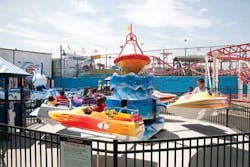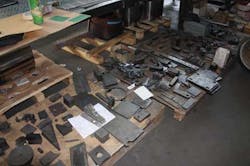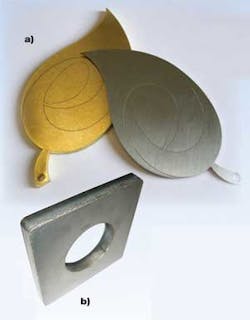Antonio Vendramini
Company invests in a laser system to conquer new markets
We have experienced a number of different cases concerning the choice of a laser system. Most of the time, the decision was the outcome of careful evaluation, in which the most important consideration was the promise of a rapid economic return on the investment made. We have rarely seen a case in which a laser system was the only possible choice because no other solution would have been acceptable for external unpredictable reasons.
This was the situation we found when we visited Ommec Moderna srl in Pozzolo, a district of the town of Villaga (in Vicenza province), a small settlement in the Belici mountains, surrounded by vineyards. In a certain sense, even the name of the company was dictated by a strange sort of imperative. In the midst of all these odd circumstances, which we will clarify in short order, the final impression was one of a hyperactive company. It was busy in many sectors and was growing by leaps and bounds in the laser beam cutting sector, taking intelligent advantage of the solutions that technology was able to offer so it could adapt, in the best possible way, to the aforementioned external contingencies.
Specialists in fabrication
We interviewed the owner of the company, Olinto Giacomuzzo, to try and clarify, first of all, the reason behind the name of this small company, because this will also serve to explain its peculiar business. Giacomuzzo, we learned, was an employee of the Zamperla company, a Vicenza-based firm that specialized in the construction of portable and permanently installed rides for amusement parks, which it also manages, as in the case of New York’s Coney Island, the oldest amusement park in America. In 1973, he decided to go into business for himself, and founded OMMEC snc, while continuing to work 100% for Zamperla.
“Our workshop was located in a small garage,” Giacomuzzo told us. “We made motors for bumper cars, programmers for the so-called “punching meters” you encounter at every small-town fair, cylinders to elevate the people on revolving rides, etc. We always tried to do our work in the most professional way and we gradually earned a name in the area. This enabled us to expand gradually in the fabrication sector, and we started producing subassemblies that were then assembled directly by the producer. In our constant striving for quality, we went from a workshop to a certified industry, using qualified materials, performing certified welding, etc. In a few years, we were known throughout the country for our production of high quality parts, as well as for our great flexibility, and we were able to manage production from the prototype to mass production. Early in the 1980s, we started collaborating with the Bologna-based company Moderna srl, a producer of machinery for washing metals, dry cleaning, ironing machines and water treatment equipment. We started making parts for the company, and when it experienced economic difficulties that led it to bankruptcy, we took over the name and continued producing only its vast range of dry cleaning and metal washing machinery. As we were not competitive in the former sector, we concentrated on the latter. We developed machines for washing bearings and engines for Trenitalia, engines for the Italian army, tramway parts for Milan and Turin, etc. That is how the company became Ommec Moderna srl in 2007, continuing to operate in the sector of amusement park rides (FIGURE 1), metal washing machinery, and marketing chemical products for these machines…until the laser came along, that same year.”
Lasers come to the company
Giacomuzzo continued his story, with the help of his son, Nevio, who has an important role in the company: “In 2007, we decided to purchase a laser system for cutting, and proceed directly to process the sheet metal parts of the systems we produced. We had two important limitations, however: the most serious one was the fact that, in this lovely part of the countryside, almost entirely devoted to grape-growing, our electrical power supply is just 45 kW and it would not have been economical for us to increase it. The other limitation was that we did not want to overstretch ourselves financially. For these reasons, we decided to purchase a ByStar unit, second (or perhaps third) hand, with a working range of 1250 x 2500 mm equipped with a 1500W CO2 source. This machine proved useful right away, although it limited us as regards the thicknesses we could cut, but the power supply problem had been decisive for us. We immediately took steps to provide the machine with a suction cup loading unit to facilitate positioning the sheet metal on the unit’s two work tables. We could see the great advantages of laser cutting (in terms of quality and precision) for our direct use in place of the previous processing system for machine tools. We were not interested, however, in working on commission for other companies, in part due to the limited possibilities offered by the machine, but most of all because our internal needs left little room for anything else.”
He continued: “After the first experiences, we had to face the problem of how to acquire a more competitive machine because it was clear that the laser was the technology of the future for processing sheet metal, and we wanted to move into that future through the front door, using the great potential offered by the new fiber laser sources that, in the meantime, were starting to dominate the market. This would also have enabled us to solve our power supply problems in view of the great efficiency of these generators. We analyzed our needs with the opportunities that were presented to us through the use of a 2 kW fiber laser: these lasers not only exceeded the performance we were used to getting with our CO2 source, but in the thicknesses of about 3 mm or less we actually got much better performance in terms of speed.
“At that point we were once again attracted by the opportunities of working on commission: since we were already clients of an important nearby Group that needed to cut very thin sheets at high speed and without burrs for the metal trim parts it produced,” said Olinto Giacomuzzo. “We considered the new Syncrono Fiber solution offered by Prima Industrie, which had already demonstrated operating with CO2 sources, its excellent performance in cutting thin sheets. With a single new purchase we would be able to satisfy a number of our needs: we would have an innovative solution (operating on a larger field: 3000 x 1500 mm); we would not exceed our power limitations; we would be able to do commission work, starting with an important, known client. Using a fiber source we would also have the possibility of expanding our operations to include all those materials, like copper, brass and aluminum alloys, that are difficult to cut with a CO2 laser on account of the high reflectivity of the emission wavelength (10.6 µm) of these sources.”
The Syncrono Fiber system (FIGURE 2) is capable of achieving, on thin sheets, speeds and productivity as much as four times higher than the model equipped with a high power CO2 laser. To achieve this performance, a machine with very high dynamics is necessary. With its revolutionary architecture and 6 g of acceleration, the Syncrono is the only machine on the market that can reach the dynamics permitted by the fiber technology for thin sheets. The Syncrono system is based on a unique solution. It is actually two perfectly synchronized machines in one: a small, lightweight head with very high dynamics and minimum weights in motion, and a larger machine with a larger work area (3000x1500 mm). The two machines are coordinated by patented algorithms, for the most advantageous distribution of the movements between the axes. An active compensation mechanism eliminates the vibrations deriving from the high dynamic. The use of the fiber sources also drastically reduces electrical consumption; it eliminates laser gases, alignment of the optics, high pressure compressors and maintenance of the laser. Even the floor space occupied by the system is smaller.
We asked Olinto’s son Nevio what happened in the company right after they stipulated the contract. “Even though we knew that ours would be the first laser installation for 2D using fiber sources produced by Prima Industrie, we were extremely confident in the success of the installation, because we were familiar with this supplier’s quality,” said Nevio Giacomuzzo. “We installed the system in April 2010 and immediately started production (I should add, among other things, that we kept our sheet metal loading unit and adapted it to the new system). We had a few doubts in the first two months regarding the inclusion of a mechanical shutter that Prima Industrie had recommended on the basis of its experience with systems using CO2 lasers, but then after that we started working successfully.”
We asked him about the development of the commission work they started doing when they acquired the new laser system. “We started this new branch of the business, as we said before, processing thin metal trim (FIGURE 3), and were able to furnish excellent quality solutions in about 30% less time than we would have been able to do with the CO2 laser. We also generated great interest with our ability to cut pieces in copper and other reflective materials (FIGURE 4) that the company had been forced to cut previously with “water jet” equipment, which necessitated manual honing of the edges afterward. This was an important success for us. After that we quickly extended our operations to include different applications on thicker materials. We have not been able to highlight the high performance of the Syncrono unit directly in performing contoured cuts, but we used the experience gained with the previous installation (where we always had to invent artifices to improve performance) and were able, above all, to benefit from the great advantage of the lower management costs typical of fiber laser technology.”
The future
We asked Nevio to analyze his business situation after the acquisition of the fiber laser system and tell us what had changed in his order portfolio. Nevio told us: “At the present time, we are operating about 50% in the ride sector, about 30% in the production of our metal washing machines and, for the remaining 20% in other fabrication work, including commission work. In the near future we would like to maintain our position as commission processors, with the ability to process a wide range of materials with rapid delivery, but above all we would like to diversify the field of our main production sectors, expanding to the production of fabrication and structures for other types of machines produced in the Vicenza district.” His father, Olinto, adds: “However this depends on our ability to enlarge our factory building with construction in the external area we are now using for storage. We are very hopeful about that.”
We had another question for Nevio, however, because we could not help wondering where he found all the design and management capabilities within the company to make this market expansion. His reply was surprising: “We are already doing a large amount of fabrication work, in which, of course, we use parts cut with the new laser such as equipment for stands, irrigators for agriculture, structures and buildings. I design and calculate all these parts myself. I see nothing unusual in trying to enter important sectors for the industry of the Vicenza district where our business is located.” Amazed, we ask him how many people are currently employed by the company. “We have 8 employees, plus four members of the family: my father and I, my brother, who follows the laser processing activities and my mother, who takes care of the books.”
This company is a good example of what it means to be a small/medium Italian industry with the ability to react to the crisis by investing in new processing systems and continue with confidence to acquire new markets.
Dr. Antonio Vendramini([email protected]) is a well-known international consultant on industrial laser material processing, a prolific author and contributor to his own publication, Applicazioni Laser and to Industrial Laser Solutions. His company, Lasertec s.a.s, is located in Segrate, Italy, near Milan.
More Industrial Laser Solutions Current Issue Articles
More Industrial Laser Solutions Archives Issue Articles



